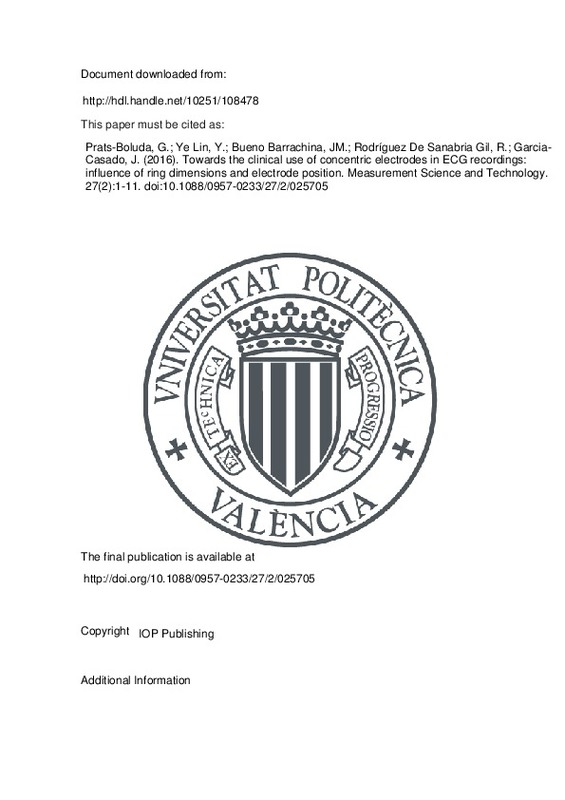JavaScript is disabled for your browser. Some features of this site may not work without it.
Buscar en RiuNet
Listar
Mi cuenta
Estadísticas
Ayuda RiuNet
Admin. UPV
Towards the clinical use of concentric electrodes in ECG recordings: influence of ring dimensions and electrode position
Mostrar el registro sencillo del ítem
Ficheros en el ítem
| dc.contributor.author | Prats-Boluda, Gema
|
es_ES |
| dc.contributor.author | Ye Lin, Yiyao
|
es_ES |
| dc.contributor.author | Bueno Barrachina, José Manuel
|
es_ES |
| dc.contributor.author | Rodríguez de Sanabria Gil, Rafael
|
es_ES |
| dc.contributor.author | Garcia-Casado, Javier
|
es_ES |
| dc.date.accessioned | 2018-09-28T04:34:16Z | |
| dc.date.available | 2018-09-28T04:34:16Z | |
| dc.date.issued | 2016 | es_ES |
| dc.identifier.issn | 0957-0233 | es_ES |
| dc.identifier.uri | http://hdl.handle.net/10251/108478 | |
| dc.description.abstract | [EN] To overcome the limited spatial resolution of standard 12-lead ECG recordings, concentric ring electrodes (CRE) have been proposed to provide valuable data for the diagnosis of a wide range of cardiac abnormalities, including infarction and arrhythmia. Although theoretical studies indicate that the dimensions of the CRE regulate the depth of the electric dipoles sensed by these electrodes, this has not been experimentally confirmed. The aim of this work was to analyze the influence of CRE dimensions and position of a wireless multi-CRE sensor node on the cardiac signal recorded. For this, four wireless multichannel ECG recording nodes based on flexible multi-ring electrodes were placed at positions CMV1 (position comparable to V1), CMV2, CMV4R and CMV5; each node providing three bipolar concentric ECG signals (BC-ECG). Standard 12-lead ECG and 12 BC-ECG signals were recorded in 29 volunteers. The results revealed that a ring with an outer diameter of 33.5 mm achieves a balance between the ease-of-use and spatial resolution of smaller electrodes and improved detectability and higher amplitudes of signals from larger ring electrodes. Although a standard 12-lead ECG outperforms BC-ECC recordings in detectability of cardiac waves, if the relative amplitude of the wave is also considered, BC-ECG at CMV1 proved superior at picking up atrial activity. In fact, in most of the BC-ECG signals picked up at CMV1, P1 and P2 atrial activity waves were more clearly identified than in simultaneous 12-Lead ECG signals. Likewise, BC-ECG signals revealed higher spatial resolution in detecting anomalous electrical activity in local regions, such as impaired intraventricular driving, or atrioventricular blocks. Finally, the wireless multi-CRE sensor node provides enhanced comfort and handling to both patient and clinician over wired systems. | es_ES |
| dc.description.sponsorship | Research supported in part by: a grant from the Conselleria d'Educacio, Cultura i Esport, Generalitat Valenciana Conselleria (GV/2014/029), two grants from the Universitat Politecnica de Valencia (SP20120490 and INNOVA SP20120469) and by a VLC_Campus grant (Prematuro 2013-0507) | |
| dc.language | Inglés | es_ES |
| dc.publisher | IOP Publishing | es_ES |
| dc.relation.ispartof | Measurement Science and Technology | es_ES |
| dc.rights | Reserva de todos los derechos | es_ES |
| dc.subject | Multi-CRE electrode | es_ES |
| dc.subject | BC-ECG recording | es_ES |
| dc.subject | Local cardiac activity | es_ES |
| dc.subject.classification | ORGANIZACION DE EMPRESAS | es_ES |
| dc.subject.classification | INGENIERIA ELECTRICA | es_ES |
| dc.subject.classification | TECNOLOGIA ELECTRONICA | es_ES |
| dc.title | Towards the clinical use of concentric electrodes in ECG recordings: influence of ring dimensions and electrode position | es_ES |
| dc.type | Artículo | es_ES |
| dc.identifier.doi | 10.1088/0957-0233/27/2/025705 | es_ES |
| dc.relation.projectID | info:eu-repo/grantAgreement/GVA//GV%2F2014%2F029/ | es_ES |
| dc.relation.projectID | info:eu-repo/grantAgreement/UPV//SP20120469/ | es_ES |
| dc.relation.projectID | info:eu-repo/grantAgreement/UPV//SP20120490/ | es_ES |
| dc.relation.projectID | info:eu-repo/grantAgreement/IISLAFE//Prematuro%2F2013-0507/ | |
| dc.rights.accessRights | Abierto | es_ES |
| dc.contributor.affiliation | Universitat Politècnica de València. Departamento de Ingeniería Electrónica - Departament d'Enginyeria Electrònica | es_ES |
| dc.contributor.affiliation | Universitat Politècnica de València. Departamento de Ingeniería Eléctrica - Departament d'Enginyeria Elèctrica | es_ES |
| dc.contributor.affiliation | Universitat Politècnica de València. Departamento de Organización de Empresas - Departament d'Organització d'Empreses | es_ES |
| dc.description.bibliographicCitation | Prats-Boluda, G.; Ye Lin, Y.; Bueno Barrachina, JM.; Rodríguez De Sanabria Gil, R.; Garcia-Casado, J. (2016). Towards the clinical use of concentric electrodes in ECG recordings: influence of ring dimensions and electrode position. Measurement Science and Technology. 27(2):1-11. https://doi.org/10.1088/0957-0233/27/2/025705 | es_ES |
| dc.description.accrualMethod | S | es_ES |
| dc.relation.publisherversion | http://doi.org/10.1088/0957-0233/27/2/025705 | es_ES |
| dc.description.upvformatpinicio | 1 | es_ES |
| dc.description.upvformatpfin | 11 | es_ES |
| dc.type.version | info:eu-repo/semantics/publishedVersion | es_ES |
| dc.description.volume | 27 | es_ES |
| dc.description.issue | 2 | es_ES |
| dc.relation.pasarela | S\305163 | es_ES |
| dc.contributor.funder | Generalitat Valenciana | es_ES |
| dc.contributor.funder | Universitat Politècnica de València | es_ES |
| dc.contributor.funder | Instituto de Investigación Sanitaria La Fe |







![[Cerrado]](/themes/UPV/images/candado.png)

